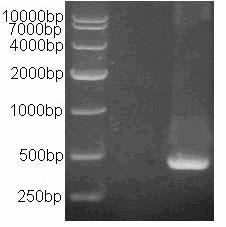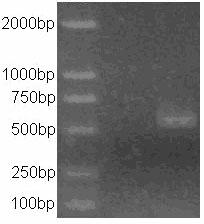Bambusa emeiensis 'viridiflavus' chlorophyll degradation pathway related protein and encoding gene thereof as well as application of encoding gene
A technology for chlorophyll degradation and related proteins, which is applied in the field of chlorophyll degradation and metabolic pathway related proteins and their coding genes and applications of cinnamon bamboo, chlorophyll degradation and metabolic pathway related proteins and their coding genes and applications, which can solve the problem of lack of genetic resources, etc. question
- Summary
- Abstract
- Description
- Claims
- Application Information
AI Technical Summary
Problems solved by technology
Method used
Image
Examples
Embodiment 1
[0021] Example 1, Chlorophyll Degradation and Metabolism Regulatory Related Protein Coding Genes BeCRN1 obtained.
[0022] 1.1 RNA extraction.
[0023] Take about 0.1g of the aged golden silk ci bamboo leaf material. After the liquid nitrogen is fully ground, transfer to a 1.5ml centrifuge tube, add 1ml TRIzol (Invitrogen Company), mix well, let stand at room temperature for 15 minutes, add 0.2ml chloroform:isoamyl alcohol (24:1), shake vigorously for 15 seconds, and then room temperature Leave for 5 minutes, centrifuge at 13000rpm, 4°C for 15 minutes. Take the supernatant and add an equal volume of isopropanol, mix carefully, place at room temperature for 15 minutes, centrifuge at 13000 rpm, 4°C for 15 minutes. The precipitate was washed with 70% ethanol and dried at room temperature for 15 minutes. Dissolve in an appropriate amount of ddH treated with 0.1% DEPC 2 O water, stored at -80°C for later use.
[0024] 1.2 cDNA first-strand synthesis and reverse transcription...
Embodiment 2
[0115] Example 2: BeCRN1 functional analysis.
[0116] 2.1 Sequence comparison analysis.
[0117] In order to analyze the relationship between BeCRN1 and CRN1 proteins of other species, the phylogenetic tree of BeCRN1 and NYE proteins of other species was established by using MEGA software. The results showed that BeCRN1 was closest to CRN1 in barley ( figure 1 -a). The homology of BeCRN1 with other species was analyzed by Genedoc software. The analysis results showed that BeCRN1 had great homology with CRN1 proteins of other species ( figure 1 -b). OsCRN1 (rice CRN1), SbCRN1 (sorghum CRN1), VvCRN1 (grape CRN1), AtCRN1 (Arabidopsis CRN1).
[0118] 2.2 BeCRN1 Gene function analysis.
[0119] 2.2.1 Complementary Arabidopsis crn1-1 Vector construction.
[0120] Using primers CRN1-S and CRN1-A as primers to amplify Arabidopsis BeCRN1 The coding frame was cloned into pMD19-T vector (Takara), after the sequence was correct. use KpnI (GGTACC) and PstI (CTGCAG) (...
PUM
 Login to View More
Login to View More Abstract
Description
Claims
Application Information
 Login to View More
Login to View More - R&D
- Intellectual Property
- Life Sciences
- Materials
- Tech Scout
- Unparalleled Data Quality
- Higher Quality Content
- 60% Fewer Hallucinations
Browse by: Latest US Patents, China's latest patents, Technical Efficacy Thesaurus, Application Domain, Technology Topic, Popular Technical Reports.
© 2025 PatSnap. All rights reserved.Legal|Privacy policy|Modern Slavery Act Transparency Statement|Sitemap|About US| Contact US: help@patsnap.com



